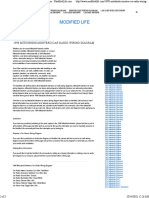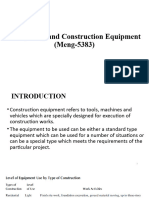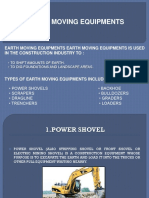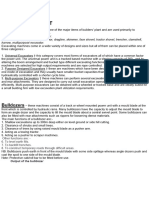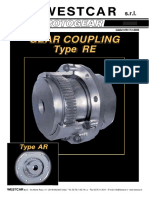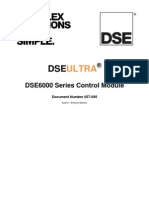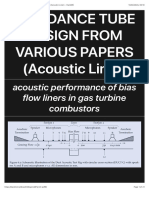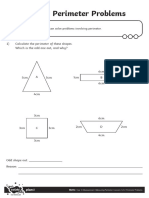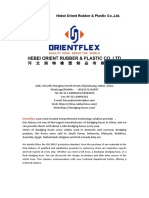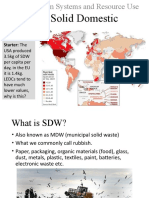MODULE 2 Construction Equipments
Uploaded by
Surekha Abhishek RaoMODULE 2 Construction Equipments
Uploaded by
Surekha Abhishek RaoMODULE 2
Construction Equipments
General:
Construction equipment today is specially designed by the manufacturer to perform certain
mechanical operations that accomplish a work activity. Working capacity is a direct function of
the size of the machine and the power of motor. These simple relationships exist- the larger the
machine, the more power required for the operation, the greater the production capacity and the
greater the cost to own and operate.
Plant, equipment and tools used in construction operations are priced in the following three
categories in the estimate:
1. Small tools and Consumables: Hand tools up to certain value together with blades. Drill
bits and other consumables used in the project are priced as a percentage of the total
labour price of the estimate.
2. Equipment usually shared by a number of work activities: These kinds of equipment
items are kept at the site over a period of time and used in the work in progress.
3. Equipment used for specific tasks: These are capital items and used in projects such as
digging trench or hoisting material into specified slots. This equipment is period directly
against take off quantities for the project is to be used on.
Classification of Construction Equipment:
Construction equipment can be broadly classified on the basis of their functions as under:
1. Earthwork Equipment:
i)Earth cutting and moving equipment: Bulldozers, Scrapers, Front – end loaders, Motor
graders.
ii) Excavation and Lifting Equipment: Backhoes, Power Shovels, Draglines, Clamshells.
iii) Loading Equipment: Loaders, Shovels, Excavators.
iv) Transportation Equipment: Tippers, Dump Trucks, Scrapers, Conveyors.
v) Compacting Equipment: Tamping Foot Rollers, Smooth Wheel Rollers, Pneumatic
Rollers, Vibratory Rollers, Plate Compactors.
2. Concreting Plant and Equipments:
i)Production Equipment: Batching Plants, Concrete Mixers.
ii)Transportation Equipment: Truck mixers, Concrete dumpers.
iii)Placing equipment: Concrete pumps, Conveyors, Hoists, Grouting Equipments.
iv) Concrete Vibrating Equipments: Needle vibrators, Plate compactors.
3. Material Hoisting Equipments:
i)Hoists: Fixed. Mobile, Fork- lifts.
ii)Mobile Cranes: Crawler- mounted, self -propelled rubber tyred, truck mounted.
iii)Tower Cranes: Stationary Travelingtype.
4. Special Purpose Heavy Construction Plant and Equipments
i)Aggregate production Equipment: Crushing Plant, Rock Blasting Equipment, Screening
Plants
ii)Concrete Paving Equipments: Concrete paver finishers
iii)Pile driving equipment: Pile driving hammers
iv) Asphalt mix production and placement equipment: Asphalt plants, asphalt pavers
v) Tunneling equipment: Drill jumbos, Muck- hauling equipment, Rock bolters, Tunnel
boring machines.
5. Support and Utility Services Equipments:
i)Pumping and Dewatering equipment
ii)Pipe laying equipment.
iii)Generators
iv)Welding equipments
TRACTORS
Tractor is a multipurpose machine. It includes light models used for agricultural and small hauling
works. It is versatile equipment having a variety of uses in road construction, such as
To pull rippers and rooters. To pull towed scrapers. To pull sheepsfoot rollers. To push load scrapers.
To pull towed pneumatic rollers
There are two main types of tractors:
1. Crawler type
2. Pneumatic wheel type
Crawler tractors have a low maximum speed, around 10kmph and are used primarily where high
speeds are sacrificed in order to obtain good traction and high draw-bar pull. They are also preferred
where the ground is not firm. Crawler mounted dozers have a digging and travelling with load speed
of about 2.5kmph.
Pneumatic wheeled tractors are used for moving at high speeds (up to 50kmph) on firm ground.
Pneumatic wheeled dozers have a digging and travelling with load speed of about 4 to 5 kmph.
Now a days wheeled tractor units are used commonly for all earth moving jobs.
TRACTOR DOZERS
A tractor dozer, popularly called bull-dozer, is a tractor with a 3-3.5m long, 0.9-1.2m height blade
mounted in front of it. If the blade of the equipment is set at angle, it is called an angle dozer. The
blade of some dozers can be tilted in the vertical plane to a tilt of about 1 in 10. The equipment is
versatile and can perform the following operations:
1. Clearing and grubbing land of vegetation and tree stumps.
2. Removing top soil from borrow areas.
3. Moving earth for short distances, say up to 100m.
4. Box- cutting a formation for laying pavement layers.
5. Opening up pilot road formations in steep hill sides to such a width that other equipment can
move in and complete the work.
6. Spreading earth in layers.
Type of dozers:
0
Angle dozer: Meant to push its loads at an angle of approximately 30 to the direction of travel of the
tractor.
Specially useful in side-hill work where the material is to be piled in a long wind row to one side of
the line of travel.
Tilt dozer: Designed such that the blade can be tilted by raising one corner up to 10inches above the
other so that the machine can open up an excavation in hard ground or start excavation for a ditch or a
trench.
Tree dozer: It has a V-blade at the front end attachment so that trees can be pushed by the upper frame
of the blade while the lower edge is fitted with a stumper that can drive into the root.
SCRAPERS
Scrapers dig their own load, as they move forward. They combine the operations of digging, loading,
hauling and discharging. There are main three operators is there:
Bowl or Bucket- The bowl is the loading and carrying component of a scraper. It has a cutting edge that
extends horizontally across its front bottom edge. The bow is lowered for loading and raised during travel.
Apron or Lip- the apron is the front wall of the bowl. It is independent of the bowl. It is raised during the
loading and dumping operations to enable the material to flow into or out of the bowl. The apron is
lowered during hauling to prevent material spillage.
Ejector or Tail gate- the ejector is the rear vertical wall of the bowl. The ejector is in the rear position
during and hauling. During spreading, the ejector is activated and moves forward, providing positive
discharge of the material in bowl.
The working principle of scraper is a cutting blade, which can be raised or lowered up to 20cm, is pulled
through the earth causing it to travel up the face of the blade into the bowl of the scraper. Some of the
earth falls forward into a carrying apron. When the bowl is full, the aprons are lowered to prevent spillage
and the cutting edge is raised. After hauling, the material is dumped by lowering the cutting edge to the
desired height above the fill and opening the front apron. Two type of scrappers Towed and Motorized
scrapers. Towed scrapers are available in size of 7-12cum and used for short hauling, say 150-500m, at a
maximum speed of 10kmph.
Motorized scrapers of size up to 25cum and haul for 500-1500m with 30kmph speed.
USES
1. Better loading ability in loose free flowing material.
2. It can operated independently.
3.Additional of ripper teeth to cutting hard compacted mate.
GRADERS
It principally consist a blade below a framework. The blade be lowered, lifted or rotated. Graders are used
for a number of purposes:
1. For spreading heaped earth into layers.
2. For shaping the cross-section during construction.
3. For maintaining the cross-section of embankment.
4. For maintaining gravel surface.
Graders are of two types: Towed and Motorized. The towed grader is by a tractor and is usually made in
small size.
Motor grader has a blade of about 3.5m, but its effective length during spreading becomes 2.75m.The
0
blade can be set at any angle (360 horizontal) and some time vertically tilted depend upon work. A 100-
110HP motor grader is a popular size. The normal grading speed is 3kmph. The output of a grader for
spreading the earth, which is achieved generally in 4 passes, is about
1300sqm per hour, assuming 65% operating efficiency and a 50min working hour. Assuming a normal
compacted thickness of layer of 15cm, the output in terms of compacted volume becomes about 200cum
per hour.
APPLICATION
1. Used for leveling or finishing earth work, making and maintaining project roads, construction of
air fields and land reclamation.
2. The rollers can be attached to the rear, to compact the graded surface.
3. Used in material mixing, hard surface cutting and snow clearance.
4. Used particularly base course spreading, leveling bank cutting etc.
EXCAVATION EQUIPMENT
Dipper or Power shovel
These are used primarily to excavate earth & load into trucks or tractor pulled wagons. They are capable
of excavating all classes of earth, except solid rock without prior loosening. They are mounted on
crawlers tracks or mounted on rubber tyred wheel crawler mounted shovels have very low speeds which
permit them to operate on soft ground. Single engine self propelled units are powered & operated from
the excavator cab.
Working principle is digging above the machine base level to upwards. It consists of mounting cab,
boom, dipper stick & dipper. When shovel is in correct position near the earth, the dipper is lowered to
the floor of the pit, with the teeth pointing into the face. To start the machine a crowding force is applied
through the shipper shaft & at the sometime tension is applied to the hoisting line to pull the dipper up the
face of pit. If the depth of the face is deep considering the type of soil & the size of the dipper the dipper
will be filled as it reaches the top of the face. If the depth of face is shallow it’ll not be possible to fill the
dipper completely without excessive crowding & hoisting tensions. This subjects the equipment to
excessive strains & reduces the output of the unit. If the depth of the face is greater than required to fill
the dipper when operating under favorable crowd & hoist. It’ll be necessary to reduce the depth of
penetration of the dipper into the face if the full face is to be excavated. The pit will be excavated after the
upper portion of the face is removed.
APPLICATION
1.It can effectively operate from a lower level where it stands & depth of face to be excavated is
not too shallow.
2.It carry large load and loading effect is very good to truck.
3.If blasted rock is to be excavated the large size dipper will handle bigger rocks. If the material
to be excavated is hard & tough, the dipper of the large shovel which exists higher pressures will
handle the material more easily.
LIMITATIONS OF POWER SHOVEL
1. The cost of transporting a large shovel is higher than for a smaller one.
2. Not possible to excavate soil below ground.
3. Distance b/w foot & digging is less and not well suitable for wet soil.
4. If high output rate is needed in the project a large shovel must be used.
5. More shovels rotation required.
6.More wears parts.
DRAGLINE:
In dragline, larger booms are provided, which allows digging & dumping over long distances as compared
to the power shovel. It in most suitable for excavating the channels & canal, can handle wet material &
suitable for excavation under water. One advantage of dragline is machine can be positioned on a higher
elevation where trenches are excavated. It can dig materials below its track level & can handle only soft
material. Capacity of the dragline is indicated by the bucket capacity measured in cum & generally
available in 1 to15 cum capacities.
Working principle of dragline is by bucket is thrown out from the dragline on the top of the earth to be
excavated and then pulled back towards the base of the machine. Dragline consists of the boom, bucket,
hoist cable, dump cable & drag line. Excavating is accomplished by pulling the bucket towards the
machine while regulating the digging depth by means of the tension maintained in the hoist cable. When
the bucket is filled, the operator takes in on the hoist. The bucket is so constructed that it’ll not dump its
contents unit it is desired. Hoisting, swinging & dumping of the loaded bucket follow in that order then
the cycle is repeated. Dumping is accomplished by releasing the drag cable
Draglines have following types of buckets,
Light: These are suitable for loose, dry soils, sand & gravel.
Medium: These are used for clays & compacted gravel….etc. where bucket teeth penetrates with
difficulty.
Heavy: These buckets are used for handling hard materials & broken rocks.
It is necessary to consider the weight of the bucket, since weight of the bucket with weight of the material
in it is determined by the boom strength.
APPLICATION
1. Below ground level is excavated easily.
2. Close trimming is required.
3.It swing horizontally at any angle and loading process is quick.
LIMITATIONS
1. Keep bucket teeth sharp and built up to the proper size.
2. Dig in layers, not in ditches.
3. keep digging surface sloped up towards shovel.
4. Swing bucket unit with load cause twisted.
CLAM SHELL
It is a machine having most of the characteristics of dragline & crane in common. Clam shell consists of a
bucket of two halves or shell which is hinged together at top. The shells may be attached to the shovel-
crane units or at the boom of a drag line. The open clam-shell bucket is thrown on the top of the loose
material to be dug and as the bucket is lifted, the two halves close entrapping the material into the bucket.
This equipment is useful for excavation of soft to medium materials and loose material at or below
existing ground surface.
APPLICATION
1. Where digging or dumping in a vertical plane i.e., below at or above ground level is required.
2. For digging trenches.
3. Where materials relatively soft or medium hard.
4. For charging the materials in a bin or a stock pile.
5. Where accurate dumping is required.
HOE
This equipment also known as drag shovel or pull shovel. The equipment has ability to penetrate even the
toughest of material. Due to this ability these are commonly used in quarries which have tough digging
conditions & one prom to flooding. As the name itself indicates digging of the earth is done by dragging
or pulling of the earth is done by dragging or pulling of the bucket towards machine whereas in power
shovel bucket makes outward strokes while digging.
This shovel consists of bucket & stick, a jack boom, the stick in hoe is hinged by a pin with a boom as
shown in the figure & thus enables to take any desired turn best suited for digging or dumping
operations. The lower end of the stick carries the bucket, while the upper end comes a sheave having a
hoist cable supported on a jack boom at the other end & passes on to the hoist drum. Therefore when a
pull is applied to a hoist cable, the reaction at the hinge enables boom with stick to move up or down.
Thus the boom can take any position in vertical plane.
APPLICATION
1. For digging the trenched, footings or basements.
2. To dig materials is hard.
3. When excavation is required below the ground level & digging done at the short
span.
4. When close trimming is required during excavation.
COMPARISON
Point of Dipper shovel Dragline Backhoe Clamshell
Operation in hard Good
Good Poor Good
soil or rock.
Operation in wet
Poor Fair Poor Fair
soil or mud.
Distance b/w
footing and small Long Small Long
digging.
Loading
efficiency into Very good Fair Good Precise but slow
the vehicles. At or above Below footing Below footing At or above
Digging level.
footing level level level footing level
Cycle time as - More Slightly more High
COMPACTION EQUIPMENT:
Three-wheeled road roller
This is the most common rolling equipment and is versatile in applications. It is diesel powered; the
diameter of the front roll is around 105cm, its width being around 100cm. The diameter of the rare roll
is around 145cm, its width being around 50cm. The rolling width is around 2m. The front roll gives a
load of around 35-40 kg/cm width and the front roll gives a load of 70-80kg/cm width. The speed of
rolling is in the range 1.5-6.0kmph. The output of a three wheel roller, 8-10 T, for various jobs. The
smooth wheel roller is suitable to roll a wide range of soil, preferably granular soil and pavement
materials for the various layers. Generally 6-12 passes are needed.
Pneumatic tyred roller
Pneumatic tyred rollers consist of a box mounted over two axle, the rear axle having one more wheel
than the front and the wheels of the front axles so arranged that they are located in plan in b/w the rear
wheels. Generally there are four wheel in front and five at rare. Weight is in the range of 12-45 tonnes.
The roller is suitable for compacting non-plastic soils and silty soils. The optimum speed is 4kmph.
Pneumatic tyred rollers are also used for intermediate rolling of dense asphaltic concrete. Rolling of 12-
2
18 T is used. The tyre pressure should be a minimum of 0.5MN/m . The no. of passes required is about
8-12.
Sheepsfoot rollers
Sheepsfoot rollers consist of hollow circular drums of steel 1.2-1.5m long and 0.9-1.2m dia, with legs or
tamping feet on the circumferential area at the rate of 12-18 per square meter of area. The tamping feet on
the drums are staggered into rows. The rollers can be ballasted with water or wet soil. The weight of a
single drum is in the range 1200-1800kg when empty and 2200-2800kg when ballasted. A tractor of 45HP
can pull a single drum. A speed of 4kmph is common Sheepsfoot rollers are suitable for cohesive soil and
the moisture content of the soils should be preferably near their plastic limit. The no. of passes of
sheepsfoot rollers depends upon the type of soil, moisture content and density desired. Generally 8-16
passes are needed. Using a sheepsfoot compactor has one definite benefit. Because the top lift of soil is
always being fluffed, the process helps aerate and dry out wet clays and silts.
But the disadvantages of sheepsfoot compactors are numerous. The loose top-lift material can act as a
sponge when it rains and slow the compaction process. The loose material also slows hauling units that
deposit fill material, so haul cycle times are increased.
Vibratory rollers
Vibratory rollers have become very popular in highway engineering applications in recent years with the
growing need to compact pavement layers and subgrade to high density. Compacting to such high
density by static roller is very difficult and costly. Since vibratory rollers induce oscillations, they are
able to 1. Achieve break-down of internal friction between particles of road construction materials and
2. Bring about better orientation of particles caused by cyclic deformation. Both cohesive and non-
cohesive materials can be compacted by vibratory rollers.
Vibratory rollers are used for compacting soils and granular layers, a frequency of 1500-2500 vibrations
per minute and amplitude of 0.8-1.5mm are recommended.
COMPARISON
SL. Compaction equipment Applications
1 Smooth wheel roller 1. Earth rolling
2. Soil stabilization
3. Rolling granular base
2 Sheepsfoot roller 1. Rolling cohesive soils
3 Pneumatic tyred roller 1. Rolling non-plastic silty and silty soils
4 Vibratory roller 1. Compacting sand and cohesionless soil
2. Compacting all type of soils for obtaining high
3. Compacting bituminous bases and surfaces to
obtain high degree of compaction
5 Hand operated vibratory rollers 1. Compacting sand and cohesionless soil
2. Compacting in restricted space.
SELECTION OF CONSTRUCTION EQUIPMENT
The selection of appropriate construction equipment is an important part of job planning:
Following are the main points should be considered in the process of equipment selection:
1. Site Condition: Primary site condition factors are: Type of material to be handled, Physical
constraints onsite and hauling distances.
2. The Nature of the Work: Some factors relating to the nature of the work include payload, the
total quantity of work and the construction schedule.
3. Size of the Equipment: Size of equipment should be such that it must be able to be use with
other matching units. It the equipment selected is of large size, that will remain idle for most of the
time or shall work on part loads, which mean production cost will be more.
4 . Standerdisation: It is better to have same type and size of equipments in the project. Its means
lesser spare parts reserve, more interchangeability of parts if required, easy for the operators to
understand it, mechanics will be able to maintain and repair better as they become expert by
handling similar type of equipment.
5. Availability of Equipment: The equipment which is easily available in the market should be
purchased. It should also be ensured that the equipment is of repute and is likely to be continued to
be manufactured in future also. This is necessary for future standardization and ensuring spare parts
supply.
6. Availability of Spare parts: While selecting a particular type or make of equipment, it should be
ensured that the spare parts will be available at reasonable price throughout the working life of the
equipment. It also be ensured that the downtime of the equipment for want of spare parts may not be
more.
7.Multipurpose Equipment( Versatility): There are certain type of equipment which are not
utilized fully. Therefore if possible, they must be capable of performing more than one function.
8. Client and Project specific: The owner/ client in a certain project may have certain preferences
that are not in line with the construction company’s preferred policies as far as equipment
procurement is concerned. The schedule, quality and safety requirements demanded of a particular
project may in some cases force the company to yield to the demands of the client.
9. Labor Consideration: Shortage of manpower in some situations may lead to a decision in favour
of procuring equipment that is highly automated.
10. Use in Future projects: When equipment completes only a part of their useful life in a project,
it should be kept in view that the equipment can be used in future projects and may not become
obsolete.
11. Economic Considerations: The economic considerations such as owning costs, operating
labour costs and operating fuel costs of equipment are most important in selection of equipment.
Besides, the resale value, the replacement costs of existing equipment, and the salvage value
associated with equipment are also important.
12. Reliability of the Equipment: Equipment selected for the project must be reliable one.
13. Service Support: Service support should be available in the area of project where the equipment
shall be used. Service after sales is a mojor criteria for selection of equipment.
14. Operating Requirements: The equipment selected should be easy to operate and maintain,
acceptable to the operator and should have lesser fuel consumption.
15. Past performance: If the equipment being purchased is of mew make and model, it is desirable
to enquire about its performance from other users, who are using this make and model.
16.Reputation of the manufacturer: Warranty or guarantee offered by the manufacturer, Use of
standard components in the equipment, etc. also considered while selecting equipment.
BASIC CONCEPT ON EQUIPMENT MAINTENANCE
Maintenance includes all labour, material, plant and overhead required to sustain equipment in good
serviceable condition. It includes periodic inspection, lubrication, servicing, repairs, and overhauls.
Preventative maintenance prevents breakdowns and ensures that equipment is operational and safe
to use. Preventative maintenance consists of a number of tasks of varying technical complexity,
carried out by different groups of people. Equipment users, including clinic and operating theatre
staff, can be trained to perform many of the simple care and maintenance duties that need to be done
on a regular basis. Such as dusting, cleaning, lubricating, protecting, and checking equipment,
including safety checks.
Objectives of Maintenance
The flowing are the objectives of Maintenance
1. To maximize availability of plant, equipment and machinery for productive purposes.
2. Extend the life span of plant, equipment and other facilities by minimizing their wear and tear.
3. To ensure operational readiness of equipment at all times.
4. To reduce the cost of lost production due to breakdown.
5. To provide information to the management on the cost and effectiveness of maintenance.
6. To ensure safety through regular inspection and maintenance of plant, equipment and other facilities such
as compressor, elevators, material handling equipment etc.
Types of Maintenance:
Generally maintenance can be done in the following two types:
1. Breakdown Maintenance: In this case of maintenance, repair is done after the breakdown occurs.
2. Preventive Maintenance: In this case of maintenance, basis of prediction or on the basis of periodical
checking.
Breakdown Maintenance:
Breakdown of a machine can occur due to the following two reasons:
i) Due to unpredictable failure of Components which cannot be prevented
ii) Due to gradual wear and tear of the parts, which can be eliminated to a large extent by regular
inspections, known as preventive maintenance.
From experience it can be decided that, when a part should be replaced, so that breakdown can be avoided.
In breakdown maintenance, defects are rectified only when the machine cannot perform its function may
longer, and the production department is compelled to call on the maintenance engineers for the repairs.
After repairing the defect, the maintenance engineers do not attend the machine again until another failure
occurs.
In this type of maintenance, repair shall have to be done on failure, thus it may disrupt the whole
production, if it is performing an important work.
2. Preventive Maintenance:
Preventive maintenance is sometime is termed as “Planned maintenance “or “scheduled maintenance “or
“systematic plant maintenance” etc. It is extremely important function for the reduction of maintenance cost
and to keep the good operational condition of equipment and hence increases the reliability.
Objectives of Preventive Maintenance:
Preventive maintenance has following main objects:
a) To obtain maximum availability of the equipment by avoiding breakdowns and by reducing the
shutdown periods to a minimum.
b) To keep the machine in proper condition so as to maintain the quality of the product.
c) By minimizing the wear and tear, preserve the value of the equipment.
d) To ensure for the safety of the workers.
e) To keep the plant at the maximum production efficiency.
f) To achieve all the above objectives with the most economical combination.
Functions or Elements of Preventive maintenance:
Following are some of the important functions of the preventive maintenance programme:
i) Inspection or check- ups.
ii) Servicing including cleaning, cooling and lubrication.
iii) Planning and Scheduling
iv) Records and analysis.
v) Training to maintenance staff
vi) Storage of spare parts
Inspection and Maintenance Program:
Regular inspection of equipment is an important part of field maintenance. Regular inspection means
periodic investigation of the condition of all the components, such as under carriages, tyres and cutting
edges.
To ensure through inspection of all the vital components, detailed inspection and maintenance program
should be prepared. Detailed inspection sheets should be used for each equipment listing specific points of
inspection.
Maintenance instructions provided by the equipment manufacturer should be used as a reference in
preparing the inspection report. A maintenance program should be prepared for implementation.
The areas of responsibility of maintenance inspection personnel are as follows:
a) Regular inspecting and adjusting,
b) Scheduling machines for maintenance checks at most opportune.
c) Advising the equipment manger of apparent service needs, and
d) Keeping records of their work on machines.
Data Bank:
For any construction project involving equipment a data bank must be maintained for current and future
use. The method of record keeping in the data bank should be simple and clear. There should be enough
checks and balance to be reliable. Basic to this is the design or adoption of a good set of reporting forms.
These forms should provide for the signatures of two persons, the person entering the data and his
supervisor who checks them.
For even a minimal system, at least the following forms will be required:
a) Equipment repair history
b) Shop repair order.
c) Preventive maintenance record.
d) Service station report.
e) Daily operator inspection report
f) Operator report of equipment deficiency.
You might also like
- Advance Construction Technique and Equipemnts by Sandeep Jyani Sir PDF100% (1)Advance Construction Technique and Equipemnts by Sandeep Jyani Sir PDF120 pages
- Benjamin Britten Midsummer NightÆs Dream, A - LibrettoNo ratings yetBenjamin Britten Midsummer NightÆs Dream, A - Libretto27 pages
- 7construction Equipment Operation and MaintenanceNo ratings yet7construction Equipment Operation and Maintenance47 pages
- Heavy Duty and Construction Equipment Meng5383: Chapter OneNo ratings yetHeavy Duty and Construction Equipment Meng5383: Chapter One52 pages
- Building Technology_masongsong_research Activity 1No ratings yetBuilding Technology_masongsong_research Activity 147 pages
- Construction Planning Equipments MethodsNo ratings yetConstruction Planning Equipments Methods29 pages
- Earth Moving Equipments: Earth Moving Equipments Earth Moving Equipments Is Used in The Construction Industry To100% (1)Earth Moving Equipments: Earth Moving Equipments Earth Moving Equipments Is Used in The Construction Industry To40 pages
- Week 4c (Heavy Machineries 3) Design of Flanged SectionNo ratings yetWeek 4c (Heavy Machineries 3) Design of Flanged Section54 pages
- Earth Moving Equipment Function and Standard Productivity100% (1)Earth Moving Equipment Function and Standard Productivity5 pages
- Heavy Earth Moving Equipment A. Dozers: Key ComponentsNo ratings yetHeavy Earth Moving Equipment A. Dozers: Key Components9 pages
- 04. Introduction to Construction EquipmentNo ratings yet04. Introduction to Construction Equipment112 pages
- Farming Machinery - Combine Harvesters - With Information on the Operation and Mechanics of the Combine HarvesterFrom EverandFarming Machinery - Combine Harvesters - With Information on the Operation and Mechanics of the Combine Harvester5/5 (1)
- Module 1 - Measurement of Horizontal DistancesNo ratings yetModule 1 - Measurement of Horizontal Distances170 pages
- USAID - Briquetting Feasibility Study Sudan100% (3)USAID - Briquetting Feasibility Study Sudan95 pages
- The Fracmaxx and Big Bore Quicklatch System BrochureNo ratings yetThe Fracmaxx and Big Bore Quicklatch System Brochure2 pages
- Kevlar Fabric Chemistry and Its Applications in the Medical IndustryNo ratings yetKevlar Fabric Chemistry and Its Applications in the Medical Industry36 pages
- Clariant SDS EMULSOGEN 4156 European Community EnglishNo ratings yetClariant SDS EMULSOGEN 4156 European Community English12 pages
- Fixed Cost Incurred in Electricity ExpenseNo ratings yetFixed Cost Incurred in Electricity Expense5 pages
- IMPEDANCE TUBE DESIGN FROM VARIOUS PAPERS (Acoustic Liner) - HackMDNo ratings yetIMPEDANCE TUBE DESIGN FROM VARIOUS PAPERS (Acoustic Liner) - HackMD21 pages
- 2.1 Perimeter Varios Shapes Measure and Calculate Activity Sheet 2No ratings yet2.1 Perimeter Varios Shapes Measure and Calculate Activity Sheet 212 pages
- Power Electronics by D. W. Hart Chapter 07No ratings yetPower Electronics by D. W. Hart Chapter 0718 pages
- Fiitjee All India Test Series: JEE (Advanced) - 2020No ratings yetFiitjee All India Test Series: JEE (Advanced) - 202012 pages
